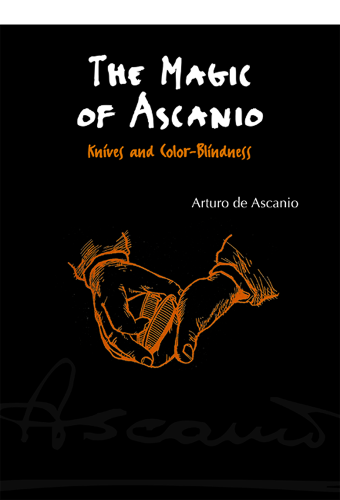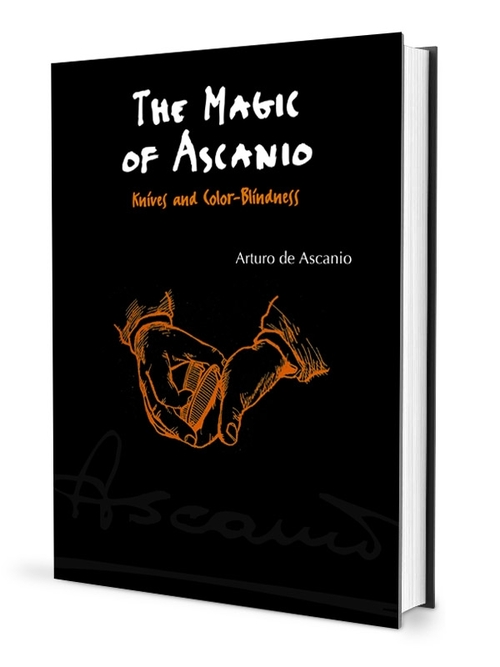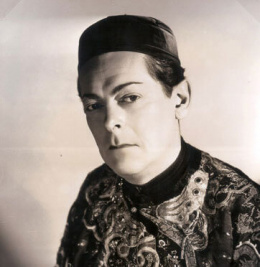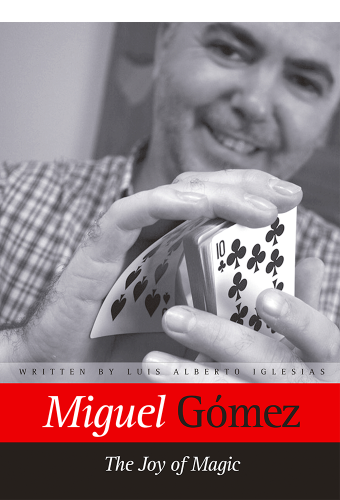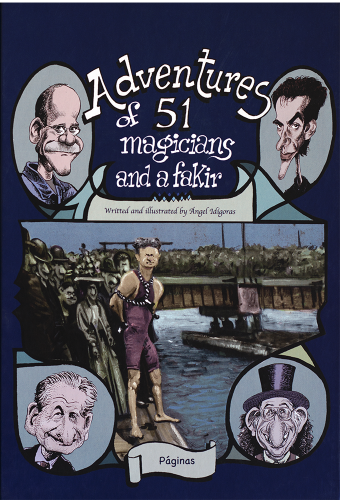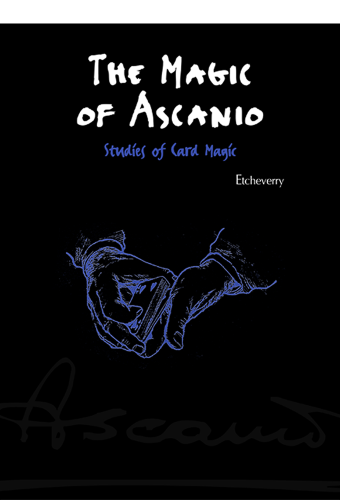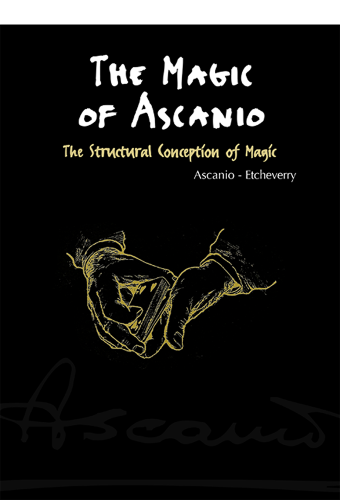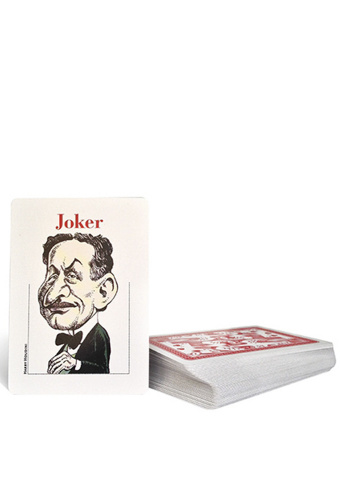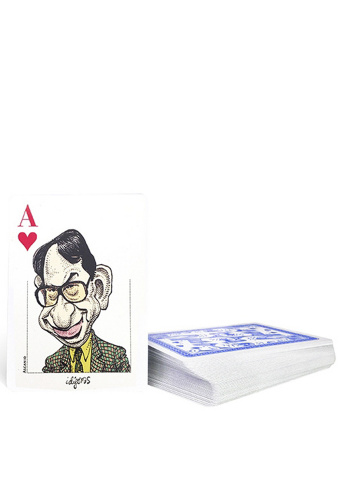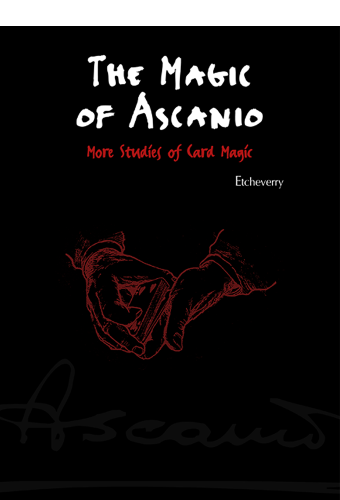The Magic of Ascanio. Volume 4 Knives and color-blindness
Arturo de Ascanio
978-84-89749-70-245,00€
Traducción: Luis Alberto Iglesias Gómez
Producción Gráfica: ilustraciones y fotografías: José Antonio Vega
132 pags.
Binding: hardcover
Format: 25cmx18cm
Arturo de Ascanio y Navaz (1926-1997), is regarded as the father of Spanish card magic. A lawyer by trade and an amateur magician, he devoted a good part of his life to magic and was one of the founders of the prestigious Escuela Mágica de Madrid.
The Structural Conception of Magic, which is the first volume of The Magic of Ascanio, is devoted to his theoretical thinking. Studies of Card Magic and More Studies of Card Magic include all of his card creations, while the fourth volume Knives and Color-Blindness is a treatise on magic with pocket knives.
Fourth Volume
Knives and Color-Blindness is not just a repertoire of sleights and routines. Above all, it encapsulates an extraordinary philosophy of magic, in which the love for detail, for naturalness and psychology alike, are given as much importance as technical skill. Ascanio's remarkable in-depth study of the psychological aspects of the "Paddle Move" and the "color change" with knives is a fundamental contribution to the magic of the color-changing knives. Arturo de Ascanio shows two specific qualities that very seldom go together: he is an extremely clear writer and also an excellent performer of sleight-of-hand. You will no doubt find that Ascanio is very good at writing about what he knows, and knows very well what he is writing about.
Binding: hardcover
Format: 25cmx18cm
Arturo de Ascanio y Navaz (1926-1997), is regarded as the father of Spanish card magic. A lawyer by trade and an amateur magician, he devoted a good part of his life to magic and was one of the founders of the prestigious Escuela Mágica de Madrid.
The Structural Conception of Magic, which is the first volume of The Magic of Ascanio, is devoted to his theoretical thinking. Studies of Card Magic and More Studies of Card Magic include all of his card creations, while the fourth volume Knives and Color-Blindness is a treatise on magic with pocket knives.
Fourth Volume
Knives and Color-Blindness is not just a repertoire of sleights and routines. Above all, it encapsulates an extraordinary philosophy of magic, in which the love for detail, for naturalness and psychology alike, are given as much importance as technical skill. Ascanio's remarkable in-depth study of the psychological aspects of the "Paddle Move" and the "color change" with knives is a fundamental contribution to the magic of the color-changing knives. Arturo de Ascanio shows two specific qualities that very seldom go together: he is an extremely clear writer and also an excellent performer of sleight-of-hand. You will no doubt find that Ascanio is very good at writing about what he knows, and knows very well what he is writing about.
Table of Contents
Foreword by Fu Manchu
Introduction by Antonio Romero
Preliminary Note
Part One: Technique
Introduction. A Few Words about Knives
Terminology
What Type of Knife Should Be Used?
The "Fairly Complete" Set
The Paddle Move
A Modern Take on the Classic Handling
Alternative Handlings
A. The Ring and Little Finger Grip
B. The Knife Held between the Left Index Finger and Thumb
C. The Hand-To-Hand Toss
D. The Classic Handling Performed with Two Knives. The V Turn
The Through-The-Fist Turn
The Third-Finger Turn
The Ultra-Fast Turn
Starting Position
The Turn Proper
Finishing Position
Points to Note
The Ultra Quick Turn with Two Knives
The Psychology of the Paddle Move
Two Psychological Procedures (Ascanio)
1. "The Sharp Knife"
2. "Breathing on the Knife"
Color Changes
The Classic Color Change
Insertion Reverse (Ascanio)
A Color Change (Bringas)
A Color Change in the Hands of a Spectator (Lewis Ganson)
One-Handed Color Change
Color Changes with Two Knives
A Color Change Using Regular Knives
Minar's Visual Color Change
The Psychology of the Color Change
Sundry Sleights
Handling the Knife as a Cigarette
The Sliding Vanish
Two Vanishes from Fu Manchu
A. Holding the Knife by One End
B. Holding the Knife by Both Ends
How to Tell the Sides of a Knife apart by Feel
Telling Two Knives apart by Feel
Switches
The Quick Switch (Ascanio)
Preparation
Execution
How to Use the Quick Switch
Other Switches
A. Switching Two Dissimilar Knives (Lewis Ganson)
B. Switching Two Knives with One Matching Side
a) Switching a Gimmicked Knife for an Ordinary One
I. The Pick and Drop Switch (Fu Manchu)
II. Sleeving into the Left Sleeve (Fu Manchu)
III. Propelling the Knife inside the Right Sleeve
b) Switching an Ordinary Knife for a Gimmicked One
Part Two: Routines
Preliminary Note
A Routine by Fred Kaps
Effect
Material
Routine
Part One
Part Two
A. Hand-To-Hand Transposition
B. The Handkerchief Move
Outline of the Routine
Notes
A Routine by Lewis Ganson
Material and Preparation
Presentation and Handling
Notes
A Routine by Arnaldo Curié
Effect
Material and Set-Up
Routine
Outline of the Routine
Variations
"Knives and Color-Blindness" (Ascanio)
Effect
Material and Preparation
Presentation and Handling
Part One: An Overt Miracle Explained
Part Two: "You Must Be Color-Blind, Sir"
Part Three: Climax
Outline of the Routine
Notes
Alternative Handlings
First Variation
Second Variation
Third Variation
Miscellanea
Two Presentations by Fu Manchu
An Idea for a Shell (Fu Manchu)
A Pull Vanish (Fu Manchu)
A Psychological Turn (Fu Manchu)
Holdouts
A Good Clean-Up (Eddie Joseph)
A Subtle Idea
An Opening Effect
The Knife in the Garter
A Holder for Miniature Knives (Ascanio)
A Pretty Color Change (Fu Manchu)
A Knife Holder (Lewis Ganson)
Part Three: First Fruits
A Justification
A Chapter by José Paytubí
A. A Psychological Turn
B. The Propeller (A Color Change)
C. A Routine
Material and Preparation
Routine
Outline of the Routine
A Routine by Martínez Muro
Material and Set-Up
Routine
Outline of the Routine
Farewell
A Big Thank You
Foreword by Fu Manchu
Introduction by Antonio Romero
Preliminary Note
Part One: Technique
Introduction. A Few Words about Knives
Terminology
What Type of Knife Should Be Used?
The "Fairly Complete" Set
The Paddle Move
A Modern Take on the Classic Handling
Alternative Handlings
A. The Ring and Little Finger Grip
B. The Knife Held between the Left Index Finger and Thumb
C. The Hand-To-Hand Toss
D. The Classic Handling Performed with Two Knives. The V Turn
The Through-The-Fist Turn
The Third-Finger Turn
The Ultra-Fast Turn
Starting Position
The Turn Proper
Finishing Position
Points to Note
The Ultra Quick Turn with Two Knives
The Psychology of the Paddle Move
Two Psychological Procedures (Ascanio)
1. "The Sharp Knife"
2. "Breathing on the Knife"
Color Changes
The Classic Color Change
Insertion Reverse (Ascanio)
A Color Change (Bringas)
A Color Change in the Hands of a Spectator (Lewis Ganson)
One-Handed Color Change
Color Changes with Two Knives
A Color Change Using Regular Knives
Minar's Visual Color Change
The Psychology of the Color Change
Sundry Sleights
Handling the Knife as a Cigarette
The Sliding Vanish
Two Vanishes from Fu Manchu
A. Holding the Knife by One End
B. Holding the Knife by Both Ends
How to Tell the Sides of a Knife apart by Feel
Telling Two Knives apart by Feel
Switches
The Quick Switch (Ascanio)
Preparation
Execution
How to Use the Quick Switch
Other Switches
A. Switching Two Dissimilar Knives (Lewis Ganson)
B. Switching Two Knives with One Matching Side
a) Switching a Gimmicked Knife for an Ordinary One
I. The Pick and Drop Switch (Fu Manchu)
II. Sleeving into the Left Sleeve (Fu Manchu)
III. Propelling the Knife inside the Right Sleeve
b) Switching an Ordinary Knife for a Gimmicked One
Part Two: Routines
Preliminary Note
A Routine by Fred Kaps
Effect
Material
Routine
Part One
Part Two
A. Hand-To-Hand Transposition
B. The Handkerchief Move
Outline of the Routine
Notes
A Routine by Lewis Ganson
Material and Preparation
Presentation and Handling
Notes
A Routine by Arnaldo Curié
Effect
Material and Set-Up
Routine
Outline of the Routine
Variations
"Knives and Color-Blindness" (Ascanio)
Effect
Material and Preparation
Presentation and Handling
Part One: An Overt Miracle Explained
Part Two: "You Must Be Color-Blind, Sir"
Part Three: Climax
Outline of the Routine
Notes
Alternative Handlings
First Variation
Second Variation
Third Variation
Miscellanea
Two Presentations by Fu Manchu
An Idea for a Shell (Fu Manchu)
A Pull Vanish (Fu Manchu)
A Psychological Turn (Fu Manchu)
Holdouts
A Good Clean-Up (Eddie Joseph)
A Subtle Idea
An Opening Effect
The Knife in the Garter
A Holder for Miniature Knives (Ascanio)
A Pretty Color Change (Fu Manchu)
A Knife Holder (Lewis Ganson)
Part Three: First Fruits
A Justification
A Chapter by José Paytubí
A. A Psychological Turn
B. The Propeller (A Color Change)
C. A Routine
Material and Preparation
Routine
Outline of the Routine
A Routine by Martínez Muro
Material and Set-Up
Routine
Outline of the Routine
Farewell
A Big Thank You
In English, the word amateur is used to designate someone who loves an art. I prefer “amateur” over “hobbyist,” as “amateur” conveys the idea of a love directed to a chosen art. Among my very few prized possessions I keep the following dedication by Dai Vernon: “To my very dear friend Dave, whom I consider one of the finest artists of this, our beloved art.” Many were the nights that Dai and I spent in conversation about magic only to be suddenly interrupted by his wife Jean, inquiring if we would care for some breakfast. The sun was up already and hours had gone by without either of us noticing. Both professional magicians, the spirit of the amateur still lived in us, thank goodness. When that spirit is lost, the essence of magic is lost.
At the “Academy of the Art of Magic” (a very exclusive magic club of only twelve members, founded in the city of New York by Dai Vernon, Sam Horowitz, Al Baker, Cardini and the sorely-missed Nate Leipzig) I would spend hours on end discussing, arguing and fighting with my colleagues, always striving for perfection in magic, rejoicing in the beaming satisfaction of solving problems elegantly. Driven by an unwavering desire to learn, we would choose a topic, break it down and build it back up again. In the world of magic, that breed of “fanatic,” or better perhaps, “perfectionist,” is very rare indeed. Most amateurs know dozens of moves and sleights that they just use to show off their skill. Every once in a while a magician appears who blends all of those subtleties into a good, solid and magical routine. My good friend Arturo de Ascanio is one such magician, a top-class sleight-of-hand artist, a magician of detail and a charming gentleman to boot. He is one of those “rare souls” who loves magic and really puts to use his knowledge. In my humble opinion, Ascanio is at the highest level in modern magic. I have been told that Arturo is working on a book of original card magic1 that will make his fantastic brand of work available for the magic community to enjoy. If he decides to include some of the gems he has shown me, I am sure the book will become one of the most outstanding works on card magic published in recent years.
Knives and Color-Blindness is just a small example of the amount of lavish detail that Ascanio puts into anything he conceives or writes. Even though most of the sleights explained in this book are not original with him, nonetheless original technical touches have been added that make them easier to perform, more natural, or more psychologically deceiving. If Ascanio has been fair in crediting the originators, it is only equally fair that we give him credit for his additions and innovations (which, only too often, prove to be the most important elements of any sleight).
The Magic of Ascanio, Ascanio/Etcheverry. Páginas. 2005-2008.
The book you are now holding is not just a repertoire of sleights and routines. Above all, it encapsulates an extraordinary philosophy of magic, in which the love for detail, for naturalness and psychology alike, are given as much importance as technical skill. Ascanio’s remarkable in-depth study of the psychological aspects of the “Paddle Move” and the “color change” with knives is a fundamental contribution to the magic of the color-changing knives.
Arturo de Ascanio shows two specific qualities that very seldom go together: he is an extremely clear writer and also an excellent performer of sleight-of-hand. You will no doubt find that Ascanio is very good at writing about what he knows, and knows very well what he is writing about. If he is so good at producing a book on a subject so specific and specialized as the color-changing knives, one can only imagine what he will be capable of doing when he finally gets to write about his own specialty, card magic!
This book is a complete treatise. The reader will not need to search other publications on magic for any required information, which is usually a troublesome task for amateurs who do not have access to vast libraries. As far as I know, this is the first book dealing exclusively with the magic of the color-changing knife, and it is my wish that this book will give a much-needed boost worldwide to this almost completely forgotten branch of sleight of hand. Magicians crying out for something new will find satisfaction here. Granted, sleight of hand with knives is not new, but the way in which Ascanio so refreshingly presents it will render meaningless any concerns about its antiquity. Anything that the eye sees for the first time is new.
It is my wish that Knives and Color-Blindness brings you at least as much pleasure as it brought me. To you who are reading these lines, my heart-felt greetings.
From one amateur to another. To Arturo, a big fraternal hug on the occasion of his first book, one written with painstaking love and lavish detail by a true lover of art, of this blessed art we all love so much.
David Bamberg (Fu Manchu)
San Sebastián, España
At the “Academy of the Art of Magic” (a very exclusive magic club of only twelve members, founded in the city of New York by Dai Vernon, Sam Horowitz, Al Baker, Cardini and the sorely-missed Nate Leipzig) I would spend hours on end discussing, arguing and fighting with my colleagues, always striving for perfection in magic, rejoicing in the beaming satisfaction of solving problems elegantly. Driven by an unwavering desire to learn, we would choose a topic, break it down and build it back up again. In the world of magic, that breed of “fanatic,” or better perhaps, “perfectionist,” is very rare indeed. Most amateurs know dozens of moves and sleights that they just use to show off their skill. Every once in a while a magician appears who blends all of those subtleties into a good, solid and magical routine. My good friend Arturo de Ascanio is one such magician, a top-class sleight-of-hand artist, a magician of detail and a charming gentleman to boot. He is one of those “rare souls” who loves magic and really puts to use his knowledge. In my humble opinion, Ascanio is at the highest level in modern magic. I have been told that Arturo is working on a book of original card magic1 that will make his fantastic brand of work available for the magic community to enjoy. If he decides to include some of the gems he has shown me, I am sure the book will become one of the most outstanding works on card magic published in recent years.
Knives and Color-Blindness is just a small example of the amount of lavish detail that Ascanio puts into anything he conceives or writes. Even though most of the sleights explained in this book are not original with him, nonetheless original technical touches have been added that make them easier to perform, more natural, or more psychologically deceiving. If Ascanio has been fair in crediting the originators, it is only equally fair that we give him credit for his additions and innovations (which, only too often, prove to be the most important elements of any sleight).
The Magic of Ascanio, Ascanio/Etcheverry. Páginas. 2005-2008.
The book you are now holding is not just a repertoire of sleights and routines. Above all, it encapsulates an extraordinary philosophy of magic, in which the love for detail, for naturalness and psychology alike, are given as much importance as technical skill. Ascanio’s remarkable in-depth study of the psychological aspects of the “Paddle Move” and the “color change” with knives is a fundamental contribution to the magic of the color-changing knives.
Arturo de Ascanio shows two specific qualities that very seldom go together: he is an extremely clear writer and also an excellent performer of sleight-of-hand. You will no doubt find that Ascanio is very good at writing about what he knows, and knows very well what he is writing about. If he is so good at producing a book on a subject so specific and specialized as the color-changing knives, one can only imagine what he will be capable of doing when he finally gets to write about his own specialty, card magic!
This book is a complete treatise. The reader will not need to search other publications on magic for any required information, which is usually a troublesome task for amateurs who do not have access to vast libraries. As far as I know, this is the first book dealing exclusively with the magic of the color-changing knife, and it is my wish that this book will give a much-needed boost worldwide to this almost completely forgotten branch of sleight of hand. Magicians crying out for something new will find satisfaction here. Granted, sleight of hand with knives is not new, but the way in which Ascanio so refreshingly presents it will render meaningless any concerns about its antiquity. Anything that the eye sees for the first time is new.
It is my wish that Knives and Color-Blindness brings you at least as much pleasure as it brought me. To you who are reading these lines, my heart-felt greetings.
From one amateur to another. To Arturo, a big fraternal hug on the occasion of his first book, one written with painstaking love and lavish detail by a true lover of art, of this blessed art we all love so much.
David Bamberg (Fu Manchu)
San Sebastián, España

